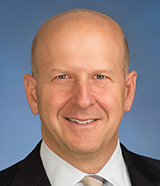Goldman Sachs’s second quarter was not a stellar one for investment banking – the traditional mainstay of the firm – and the firm might have raised eyebrows by its admission that its transaction backlog had fallen.
This being Goldman, however, there were reasonable explanations for everything. Sponsor financings were down across the industry, hurting debt capital markets (DCM), while recent big IPOs accounted for the backlog fall: in DCM and advisory it actually rose.
Understandably, therefore, the emphasis was more on the ways in which the firm is seeking to change its spots. It is continuing the shift in its funding from a reliance on wholesale markets to a more diversified range of sources, including consumer deposits. The firm reckons it can save $100 million in interest expense for every $10 billion it switches from wholesale to its retail bank Marcus.
|
David Solomon |
In fact, despite its success in attracting deposits to its Marcus platform in the US and the UK, the firm is now consciously slowing lending growth as it prepares for the consumer credit exposure that it will gain through the launch of a credit card in partnership with Apple, expected in August.
In wealth management, the acquisition of investment adviser United Capital, which should close in the next few months, will help it round out its offering to merely affluent and high net-worth clients by building on its existing Ayco business. Ultra-high net-worth clients continue to be served by Goldman’s private wealth management platform.
Equities – the only line in Goldman’s investment bank where revenues rose – showed the benefits of continuing investment in low touch. The firm posted its third-best result in the last 18 quarters, marking a clear move to second position after Morgan Stanley.
Fixed income is structurally more of a challenge at Goldman than at peers, largely due to its outsized reliance on market intermediation revenues. But its focus on broadening its client base to corporates – helped by a joint venture with the banking business – is apparently beginning to show fruit, especially in Europe, the firm says.
The continuing build-out of its transaction banking and cash management business is in the same vein – all part of an effort to reduce earnings volatility. And with good reason: Goldman’s best quarter for revenues in the last 24 months was 25% higher than its worst, compared with a 20% variance at Morgan Stanley and JPMorgan, and just 10% at Citi.
Reorganization
So far, so conventional. But another strategic announcement involved the bit of Goldman that arguably looks less like its peers than anything else: its investing and lending arm – which this quarter generated outsized returns on the back of monetizations such as its stake in Tradeweb, which floated during the period.
At the moment the details are sketchy, but chief executive David Solomon spoke of a reorganization of this business to bring its constituent parts more closely together under four pillars: private equity, growth equity, private credit and real estate. The stated aim is to accelerate the firm’s ability to raise third-party capital, which Solomon hopes will fit into the broader objective of generating more consistent fee-based revenues.
Solomon shrugged off analysts’ concerns about any conflicts of interest that might result, and which might hurt other businesses. “There are issues from time to time,” he said, but Goldman has managed such things for 30 years.
Perhaps, but there remains much that is unknown. The full details of the firm’s strategic review – started in the wake of the departure in late 2018 of former CEO Lloyd Blankfein – are still not ready to present to the market. Management told analysts that these would not be unveiled until January 2020.
Goldman’s journey to a more sustainable and predictable business model has unquestionably begun. But the firm is grappling with an existential dilemma: how to look more like others without losing what has always made it look like Goldman Sachs.


 Signal2forex.com - Best Forex robots and signals
Signal2forex.com - Best Forex robots and signals




